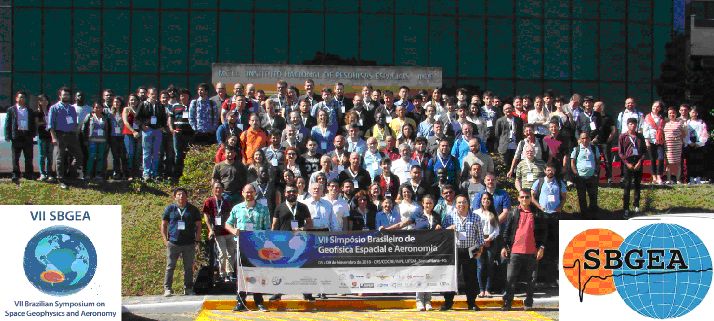
Meetings supported by VarSITI and its projects in 2018
REPORTS
AGU Chapman Conference: Particle Dynamics in the Earth's Radiation Belts
March 4÷9, 2018 Cascais, Portugal
13th conference Plasma Physics in the Solar System February 12÷16, 2018 Moscow, Russia
Dynamic Sun II: Solar Magnetism from Interior to the Corona
February 12÷16, 2018 Siem Reap, Angkor Wat, Cambodia
International School on: Equatorial and Low Latitude Ionosphere March 5÷9, 2018 Bandung, Indonesia
IAU Symposium 340: Long–Term Datasets for the Understanding of Solar and Stellar
Magnetic Cycles
February 19÷24, 2018 Jaipur, India
41th annual Seminar on Physics of the auroral phenomena
March 12÷16, 2018, Apatity, Murmansk region, Russia
The 8th biennial VERSIM Workshop:
VLF/ELF Remote Sensing of Ionospheres and Magnetosphere
March 12÷16, 2018, Apatity, Murmansk region, Russia
DKIST Critical Science Plan Workshop 5: Wave generation and propagation
April 9÷11, 2018, Newcastle upon Thyne, UK
4th International ANGWIN workshop:
Exploration of High-latitude Upper Atmosphere Wave Dynamics
April 24÷26 2018, São José dos Campos, Brazil
10th International Workshop on "Long-Term Changes and Trends in the Atmosphere"
May 14÷19, 2018, Hefei, China
10th Workshop "Solar Influences on the Magnetosphere, Ionosphere and Atmosphere"
June 4÷8, 2018 Primorsko, Bulgaria
6th International conference on "Atmosphere, Iionosphere, Safety"
June 03÷09, 2018 Kaliningrad, Russia
7th International HEPPA-SOLARIS Workshop ![]() June 11÷15, 2018 Roanoke, Virginia, USA
June 11÷15, 2018 Roanoke, Virginia, USA
7th IAGA/ICMA/SCOSTEP workshop ![]() on Vertical Coupling in the Atmosphere-Ionosphere System July 2÷6, 2018, Potsdam, Germany
on Vertical Coupling in the Atmosphere-Ionosphere System July 2÷6, 2018, Potsdam, Germany
45th Annual European Meeting ![]() on Atmospheric Studies by Optical Methods
on Atmospheric Studies by Optical Methods
August 27÷31 2018, Kiruna, Sweden
ISEST 2018 Workshop ![]() and XVIth Hvar Astrophysical Colloquium
and XVIth Hvar Astrophysical Colloquium
September 24÷28 2018, Hvar, Croatia
15th International Symposium ![]() on Equatorial Aeronomy
on Equatorial Aeronomy
October 22÷26, 2018, Ahmedabad, India
7th Symposium ![]() of Brazilian Space Geophysics and Aeronomy Society
of Brazilian Space Geophysics and Aeronomy Society
November 5÷9, 2018 Santa Maria-RS, Brazil
by Seth Claudepierre
AGU Chapman Conference:
Particle Dynamics in the Earth's Radiation Belts
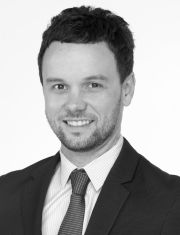 Seth Claudepierre
Seth Claudepierre
In March of 2018, radiation belt scientists descended upon the beautiful, seaside town of Cascais , Portugal , to discuss and debate the current state of the field. The week-long meeting, Particle Dynamics in the Earth’s Radiation Belts, was organized under the auspices of the American Geophysical Union (AGU) Chapman Conference program. The conference was well attended, with roughly 100 attendees representing 14 countries. There was a strong contingent (~25%) of students and early career researchers who were supported by generous travel grants from the United States National Science Foundation (NSF) and the VarSITI program of SCOSTEP. Of particular note is that over half of the invited speakers were from underrepresented groups. The conference website details the full scientific program and includes ![]() .pdf files of nearly all of the oral and poster presentations given at the conference.
.pdf files of nearly all of the oral and poster presentations given at the conference.
A special issue of the Journal of Geophysical Research – Space Physics is currently being planned.
VarSITI Newsletter Vol.17
13th conference Plasma Physics in the Solar System
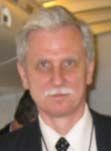 Yuri
Yermolaev
Yuri
Yermolaev

 Photograph of the 13-th conference
Photograph of the 13-th conferenceThe 13-th conference "Plasma Physics in the Solar System" was organized by Space Re- search Institute (IKI), Moscow, Russia and held in IKI on 12÷16 February, 2018. The program of the Conference included the following main traditional sections:
2. Solar wind and heliosphere,
3. Ionosphere,
4. Magnetosphere,
5.Theory of space plasma,
7.Turbulence and chaos,
as well as Special sections:
S1. Space weather forecast and applied questions of
physics of the magnetosphere and ionosphere,
S2. Wave phenomena in space plasma,
S3. The impact of space factors on the Earth's
atmosphere and climate
(see conference web-site: https://plasma2018.cosmos.ru/en)
There were more 300 participants from 6 countries. A large part of presentations were translated in real time in https://www.youtube.com/watch?v=Zl3PD_d9sJA.
The conference was supported by VarSITI grant.
VarSITI Newsletter Vol.17
Dynamic Sun II:
Solar Magnetism from Interior to the Corona
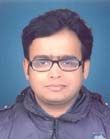 Abhishek K. Srivastava
Abhishek K. Srivastava
 Eamon Scullion
Eamon Scullion
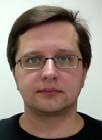 Sergiu Shelyag
Sergiu Shelyag
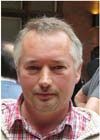 Viktor Fedun
Viktor Fedun
 Group Photo of Participants
Group Photo of ParticipantsDynamic Sun' is a new conference series, which provides a highly visible platform for the observers, theoreticians, numerical modellers and instrumentation experts in solar physics and space science to discuss cutting edge scientific challenges. The Dynamic Sun II meeting, which focused on the recent achievements in understanding photospheric, chromospheric and coronal dynamics, energy transport between the solar interior and the solar atmosphere, and dynamical processes in the confined solar transients, took place on 12-16 February 2018 in Siem Reap, Cambodia. This meeting, supported by VarSITI and AOARD, was highly successful with more than 60 attendees from more than 10 countries.
Special attention was paid to the key goals of the proposed high-altitude and ground-based instruments, e.g., DKIST, EST, Sunrise III, and Aditya‑I. To disseminate the results reported during the conference the refereed proceedings will be published as a special issue of Annales Geophysicae journal.
VarSITI Newsletter Vol.17
International School on:
Equatorial and Low Latitude Ionosphere
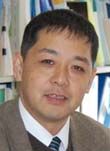 Kazuo Shiokawa
Kazuo Shiokawa
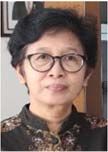 Clara Y. Yatini
Clara Y. Yatini

 Group Photo of Participants
Group Photo of ParticipantsThe International School on Equatorial and low-latitude ionosphere (ISELION2018) was held at Bandung, Indonesia on 5÷9 March 2018. Participants are 39 students and young scientists from 7 countries of Egypt, India, Indonesia, Malaysia, Nepal, Philippines, and Vietnam.
Six lecturers (Nurul Shazana Abdul Hamid, Buldan Muslim, Kazuo Shiokawa, Yoshimasa Tanaka, Mamoru Yamamoto, and Tatsuhiro Yokoyama) introduced ionospheric dynamics, measurement techniques including radars, Spread-F/plasma bubbles, and space weather for four days of Mon-Wed and Fri.
A visit of Sumedang Observatory of LAPAN and practice of ionogram processing was held on Thursday. Participants enjoyed lively discussions with the lecturers and mutual communications during this one-week school.
Details of the school are available at http://pussainsa.sains.lapan.go.id/event/iselion2018/.
This school was supported by LAPAN, ISEE/Nagoya University, JSPS core-to-core program B. Asia-Africa Science Platforms, PSTEP project, National Institute of Information and Communications Technology (NICT), and SCOSTEP.
VarSITI Newsletter Vol.17
IAU Symposium 340:
Long–Term Datasets for the Understanding of Solar and Stellar Magnetic Cycles
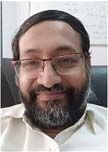 Dipankar Banerjee
Dipankar Banerjee
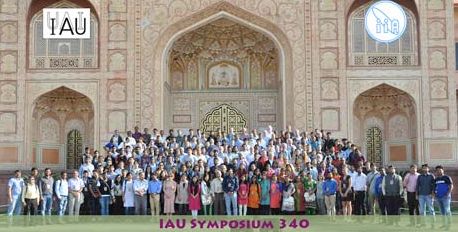 Group Photo of Participants
Group Photo of ParticipantsIAU Symposium 340 on “Long term datasets for the understanding of solar and stellar magnetic cycles” was held in Jaipur, India – February 18÷24, 2018. The symposium provided an ideal opportunity for scientists from diverse, interdisciplinary areas such as solar, stellar, space and heliospheric physics to review the status of the different long-term datasets available across the globe. The symposium provided an excellent platform to exchange ideas on the understanding of solar long-term behavior, its effects and prediction. The Kodaikanal Observatory has observed the sun at wavelengths WL, Ca‒II K, H‑alpha since 1904. The digitization process has been completed recently and raw and calibrated data was made available to the global community through an announcement during the meeting. IAU Symposium 340 enabled a comparison of recent results from a wide variety of scientific disciplines. There were eight sessions with 25 invited talks and 46 contributed presentations. There were 153 poser presentations and dedicated poster sessions were allotted each day. Each session also attracted poster awards for young scientists. A total number of 233 registered participants attended the symposium, with 157 male and 69 female candidates from 26 different countries across the globe.
All presentations are now posted at the conference website at https://www.iiap.res.in/iaus340/Home.
There were several education and outreach programs conducted during the conference, including a visit for the conference delegates to the Jantar Mantar, a world heritage site. There were workshops organized for the tourist guides with the theme of understanding the usage of the historical observatory instruments through Positional Astronomy observations.
A full day workshop on computer based data analysis on long term solar data sets was also organized for undergraduate and graduate students on the last day of the conference. 90 students attended this workshop. Nat Gopalswamy also delivered a public lecture titled “Our lifegiving star, the Sun and its dark side”.
VarSITI Newsletter Vol.18
41th annual Seminar on
Physics of the auroral phenomena
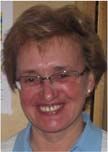 Irina Despirak
Irina Despirak
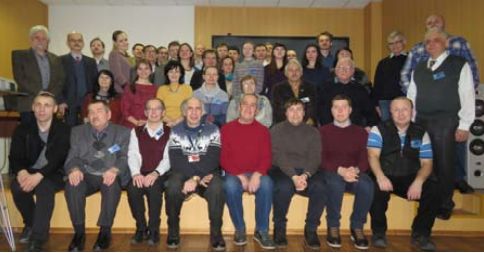 Group Photo of Participants
Group Photo of ParticipantsThe 41 st Annual Seminar "Physics of the auroral phenomena" has been held during 12÷16 March 2018 in Apatity (Murmansk region, Russia). The organizer of the Seminar is the Polar Geophysical Institute (PGI) of the Russian Academy of Science.
More than 80 representatives from 22 research institutes and universities distributed across Russia (from Kaliningrad to Yakutsk) took part in the Seminar. Of these, more than 25 people are young scientists from Moscow, St. Petersburg, Kaliningrad, Apatity and Murmansk. Among the participants there were 3 representatives of foreign research institutes (from China and Bulgaria). 56 oral and 73 poster presentations were presented. The Seminar is devoted to the discussion of the latest results obtained by Russian and foreign scientists on the space physics processes in the polar cap, auroral and subauroral regions.
The Seminar subjects cover all aspects of the solar-terrestrial relations: 1) Storms and substorms; 2) Fields, currents, particles in the magnetosphere; 3) Waves, wave-particle interaction; 4) The sun, the solar wind, cosmic rays; 5) The ionosphere and the upper atmosphere; 6) Lower atmosphere, ozone; 7) Heliobiosphere.
The VarSITI program was a co-sponsor of the Seminar and partially supported the attendance of some young scientists, students and invited speakers. The received abstracts and program are available at Abstracts Book 2018 and Program. The Seminar will be followed by publication of the proceedings, which will be available both online at http://pgia.ru/seminar/archive/ and in print. The electronic version of the seminar proceedings is published by the Russian Science Electronic Library.
VarSITI Newsletter Vol.18
The 8th biennial VERSIM Workshop:
VLF/ELF Remote Sensing of Ionospheres and Magnetosphere
 Andrei Demekhov
Andrei Demekhov
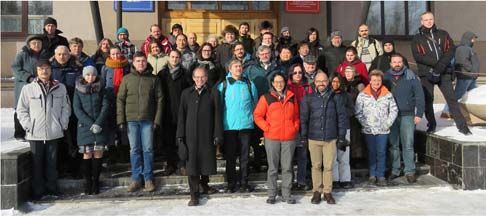 Group Photo of Participants
Group Photo of ParticipantsThe 8th biennial Workhop of VERSIM, the joint IAGA-URSI working group, was held on 19÷23 March 2018 in Polar Geophysical Institute (Apatity, Russia).
The workshop was attended by 42 participants: Russia - 19 (6 from PGI), Finland - 5, Japan - 5, Hungary - 5, Czech Republic - 3, USA - 3, France - 1, UK - 1.
64 abstracts were accepted. After some cancellations, 50 oral and 4 poster reports were presented. Each oral talk was given a 20-min time slot. The following session themes were identified, being held in a sequence:
- D-region phenomena and propagation in the Earth Ionosphere cavity;
- Wave propagation in E and F regions;
- ELF and VLF waves related to lightning discharges;
- New instruments and results of specific measurements;
- Magnetospheric ELF/VLF phenomena;
- Radiation belt dynamics (not only related to ELF/VLF waves);
- Laboratory modeling of cyclotron wave-particle interactions.
The meeting was supported by VarSITI, IAGA, and URSI. A more detailed summary of the meeting including the program and abstracts can be found at http://pgi.ru/conf/versim2018.
VarSITI Newsletter Vol.18
DKIST Critical Science Plan Workshop 5:
Wave generation and propagation
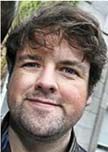 Eamon Scullion
Eamon Scullion
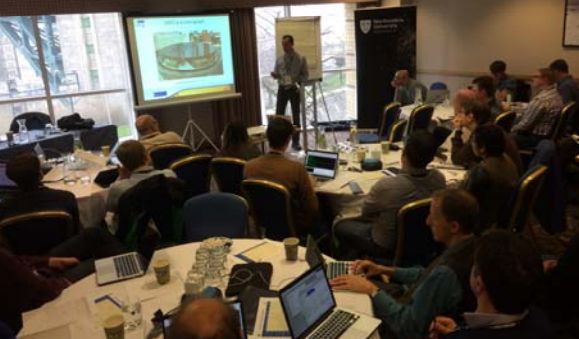 Photograph of the Workshop
Photograph of the WorkshopThe National Solar Observatory (Boulder, USA) is currently supporting 9 Critical Science Plan (CSP) development workshops, in preparation for first-light observations at the 4‑m class Daniel K Inouye Solar Telescope (DKIST: https://dkist.nso.edu/), in early 2020. DKIST is a 4‑m class ground-based solar telescope currently being constructed on Mt. Haleakala on Maui, Hawaii. The DKIST is funded by the National Science Foundation (NSF) and the Corporate Office is the Association of Universities for Research in Astronomy (AURA: http://www.aura-astronomy.org/). DKIST will be the most powerful solar telescope in the world at first light, therefore, of major interest to the global solar physics community. Dr. Eamon Scullion of the Mathematics, Physics and Electrical Engineering Dept. of Northumbria University (Newcastle upon Tyne) and Prof James McAteer of New Mexico State University (NM) organized a highly productive 2.5 day workshop, from 9÷11 April, at the Hilton Hotel Gateshead in Newcastle upon Tyne (UK). The workshop brought together 41 participants (27 UK/EU and 14 USA) consisting of senior experts, early career researchers and DKIST instrument scientists, encorporating a variety of observational, numerical and theoretical solar physics expertise. The aim of the workshop was to develop multiple Science-Use-Cases (SUCs) to form part of the DKIST Critical Science Plan, addressing the first 2 years of observing operations, specifically addressing the solar physics research of, "Wave generation and propagation". For more information see here: http://eclipse2017.nso.edu/science/dkist/dkist-critical-science-plan/workshop-5/. The highly successful outcome of the workshop was the creation of 32 unique SUCs and the continued development of 3 existing SUCs. The details of these are now published on the DKIST Critical Science Plan JIRA site (https://id.atlassian.com/login), to be made publicly visible to the solar physics community. The workshop was financially supported by VarSITI, the Science and Technology Facilities Council (STFC, UK) and the Multi-Disciplinary Research Theme (MDRT) of Extreme Environments at Northumbria University. The organisers would like to thank additional funding support towards US participation costs in the workshop from the NSO and NSF. For more information on the Solar Physics Research Group at Northumbria University (UK) see the following link: https://www.northumbria.ac.uk/sun.
VarSITI Newsletter Vol.18
4th International ANGWIN workshop:
Exploration of High-latitude Upper Atmosphere
Wave Dynamics
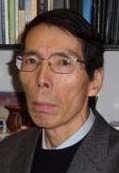 Hisao Takahashi
Hisao Takahashi
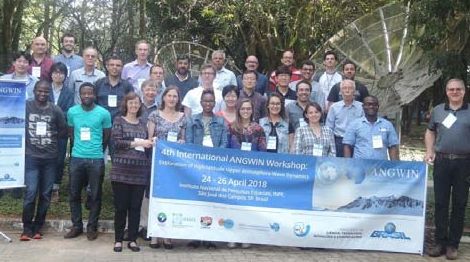 Group Photo of Participants
Group Photo of ParticipantsDuring the period from April 24 to 26, 2018, "4th International ANGWIN (ANtarctic Gravity Wave Instrument Network) Workshop" was held at National Institute for Space Research (INPE), São José dos Campos, SP, Brazil. The main purpose of the workshop was to combine together new Antarctic and Arctic observations using optical and radiowave techniques, and results with modeling studies to gain fresh knowledge and insight of their largescale effects on the general circulation of the polarregions lower, middle and upper atmosphere and ionosphere. The workshop provided an opportunity for early career scientists/students to work with some of the leading experts in this field of research. The workshop achieved the purpose with 35 participants from 8 countries (USA, UK, Germany, Island, South Africa, Korea, Japan and Brazil), and 33 oral presentations. The workshop program, abstracts and photos are available at http://www.inpe.br/angwin/. The next ANGWIN workshop will be held in Korea in 2020. We thank VarSITI/SCOSTEP and IAMS/IUGG for the financial support and encouragements.
VarSITI Newsletter Vol.18
10th International Workshop on
"Long-Term Changes and Trends in the Atmosphere"
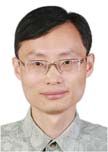 Tao Li
Tao Li
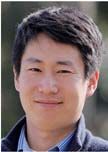 Jia Yue
Jia Yue
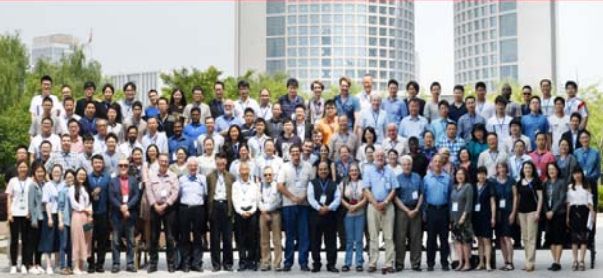 Group Photo of Participants
Group Photo of ParticipantsThe 10th Workshop on Long-Term Changes and Trends in the Atmosphere was held at Hefei, China on May 14÷18 2018. There are about 130 participants from 13 countries and regions of China, Germany, USA, Japan, Taiwan, Argentina, Czech Republic, Finland, Russia, Malaysia, India, UK, Australia, including many graduate students and young scientists. This highly successful meeting is the most attended in this trend workshop series. The main traditional sessions include trends and variability in the stratosphere, mesosphere, thermosphere, ionosphere and modeling trends. Altogether 69 oral papers (including key notes and invited papers) and 25 posters have been presented. In addition, three tutorials for students and young scientists were presented on the history of trend researches, dynamics and modeling. Jan Lastovicka gave a special seminar on how to publish in scientific journals for early career scientists. This meeting is supported by VarSITI. A special joint issue of Journal of Geophysical Research Space Physics and Journal of Geophysical Research Atmosphere is planned. Nearly all pdfs of the oral presentations will be available at: the webpage: http://trends2018.ustc.edu.cn/programs.html.
VarSITI Newsletter Vol.18
10th Workshop: Solar Influences on
the Magnetosphere, Ionosphere and Atmosphere
 Boian Kirov
Boian Kirov
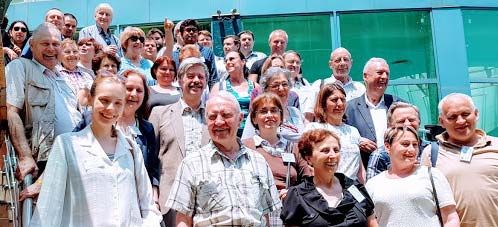 Group Photo of Participants
Group Photo of ParticipantsThe 10th Workshop "Solar Influences on the Magnetosphere, Ionosphere and Atmosphere"
was held in Primorsko, Bulgaria from 4 to 8 June 2018. The workshop, organized by the Space Cli-
mate department of the Space Research and Technology Institute at the Bulgarian Academy of Sciences, was attended by 76 participants from 15 countries. The 94 oral and poster presentations covered all aspects of solar-terrestrial influences, from physics of the Sun including predictions of future solar activity, solar transients, solar wind and its interactions with the Earth's magnetosphere, to solar effects in the ionosphere and atmosphere, including relation to climate change, to influences on the solid Earth and biosphere. The presentations and the proceedings of the workshop will be available online at
http://ws-sozopol.stil.bas.bg/.
As a part of the workshop, for the first time a summer school for young scientists "Sun, space weather and space climate" was held, organized by Dibyendu Nandi. A special session dedicated to the recent recalibrations of the sunspot indices marked the kick-off of the VarSITI project "Long-term solar variability and sunspot indices". This workshop was the first forum at which the SCOSTEP's next scientific program was publicly discussed. The next program's concept text had been sent before the workshop to all the participants, and the summary of the discussions will be provided as a feedback to the Committee for the SCOSTEP Next Scientific Program.
VarSITI Newsletter Vol.18
6th International conference on
Atmosphere, Ionosphere, Safety;
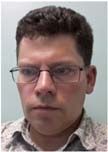 Maxim Golubkov
Maxim Golubkov
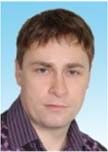 Maxim Klimenko
Maxim Klimenko
 Olga Borchevkina
Olga Borchevkina
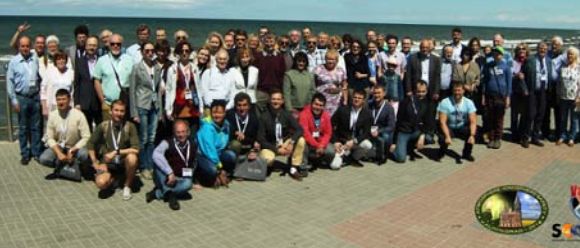 Group Photo of Participants
Group Photo of ParticipantsThe VI International Conference "Atmosphere, Ionosphere, Safety" (AIS-2018) was held at the hotel "Sambiya" (Zelenogradsk, Kaliningrad region, Russia) on June 03÷09, 2018. Participants were more than 130 scientists from 10 countries - Switzerland, Italy, Netherlands, Brazil, and Russia including 42 young scientists. The AIS-2018 conference topics cover many aspects of the solar-terrestrial physics: from the magnetospheric and plasma physics to the influence of the solar activity, meteorological and anthropogenic sources on the atmospheric climate and space weather. In the framework of the Conference the Second Baltic young scientists (<39 years old) International School on «MagnetosphereIonosphere-Atmosphere Coupling» and young scientist competition were held. 14 lecturers, 70 oral and 50 poster reports introduced very interesting and interdisciplinary aspects of atmospheric climate, atmospheric chemistry, wave-particle interaction, ionospheric physics and space weather. AIS-2018 was supported by VARSITI, RFBR and the program «5÷100» for improving competitiveness at IKBFU. Details of the conference are available at http://ais2018.ru/.
VarSITI Newsletter Vol.19
7th International HEPPA-SOLARIS Workshop
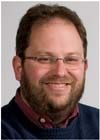 Scott Bailey
Scott Bailey
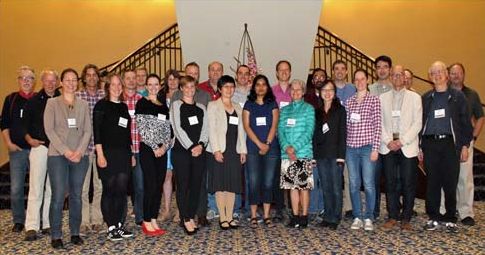 Group Photo of Participants
Group Photo of ParticipantsThe 7th HEPPA-SOLARIS Workshop was held June 11÷14 2018 in Roanoke, Virginia, USA. The focus of the workshop was on observational and modeling studies of the influences of solar radiation and energetic particle precipitation on the atmosphere and climate. Sessions were held on: solar and precipitating particle variability; solar photon and particle effects on the stratosphere and above; dynamical processes influencing the coupling of altitude regions; solar and particle effects on the troposphere and climate system; and tools for assessing solar and precipitating particle influences. There were 35 presentations including 7 posters. Participants represented 8 countries (USA, Norway, Spain, Finland, United Kingdom, Germany, Japan, Brazil). An open process for nominating invited talks led to a broad set of presentations with many new results and many stimulating discussions. In addition to VarSITI, support was provided by Virginia Tech (the host institution) as well as SPARC. Further information can be found at http://www.cpe.vt.edu/heppa.solaris.2018/.
VarSITI Newsletter Vol.19
7th IAGA/ICMA/SCOSTEP workshop on
Vertical Coupling in the Atmosphere-Ionosphere System
 Petra Koucká-Knížová
Petra Koucká-Knížová
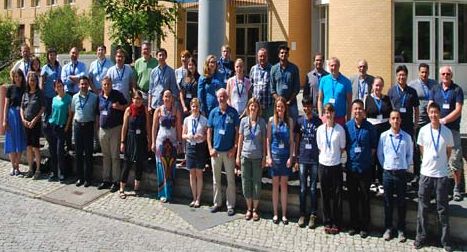 Group Photo of Participants
Group Photo of ParticipantsThe traditional
7th IAGA/ICMA/SCOSTEP Workshop on Vertical Coupling in the Atmosphere-Ionosphere System was held in the campus of the GFZ German Research Centre for Geosciences, Helmholtz Centre Potsdam from July 2÷6, 2018. Audience at the Workshop included 60 scientists from 30 institutions across 18 countries spanning Asia, Europe, Africa, North and South America. During five days of workshop over 50 oral contributions and 16 posters were presented, among them 5 solicited talks. This meeting offered an excellent opportunity for scientists of broad research area, from lower, through middle and upper atmosphere and ionosphere and magnetosphere, to present and discuss their recent results. Communication between scientists has been very fruitful and initiated further cooperation. The following meeting is planned for 2020. The organizers appreciate substantial financial support provided by VarSITI (project ROSMIC) together with IAGA and IUGG that allowed twelve scientists to participate.
VarSITI Newsletter Vol.19
45th Annual European Meeting on
Atmospheric Studies by Optical Methods
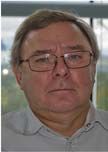 Tima Sergienko
Tima Sergienko
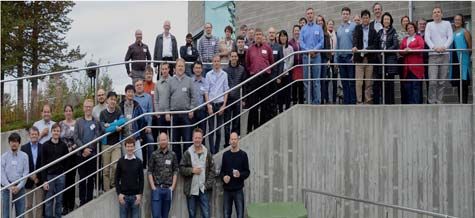 Group Photo of Participants
Group Photo of ParticipantsThe 45th Annual European Meeting on Atmospheric Studies by Optical Methods (45AM) was organized by the Swedish Institute of Space Physics in Kiruna, Sweden. The meeting lasted for one week (August 27÷31) at the end of the summer 2018. More than 50 participants took part in 45AM, presenting 50 oral and 10 poster presentations.
Although the meeting has the title "Annual European Meeting" it attracts scientist from all parts of the world, especially from North America, Japan and former Soviet Union countries. This annual meeting aims to bring together scientists and graduate students from Europe as well as from other parts of the world to exchange experiences, share scientific results, and plan and coordinate future experiments.
The meeting programme covered a wide range of phenomena where optical techniques are used to learn about processes in the atmosphere. It included seven sessions: aurora and ionosphere-thermosphere interaction; noctilucent clouds and mesospheric aeronomy; transient luminous events; aerosol and clouds; meteors; active experiments in the upper atmosphere; ground-based, in-situ and space-based instruments, new facilities; and EISCAT_3D and optical instruments.
The VarSITI program was a co-sponsor of 45AM and partially supported the attendance of some young scientists, students and invited speakers. The conference program, abstracts and photos are available at http://45am.irf.se.
VarSITI Newsletter Vol.20
ISEST 2018 Workshop
XVIth Hvar Astrophysical Colloquium
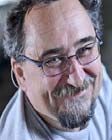 Bojan Vršnak
Bojan Vršnak
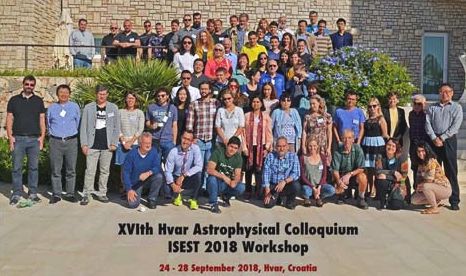 Group Photo of Participants
Group Photo of ParticipantsThe "International Study of Earth-affecting Solar Transients ISEST 2018 Workshop", organized by Hvar Observatory, Faculty of Geodesy, University of Zagreb, was held from September 24 to 28, 2018 in the Hotel Amfora, Hvar, Croatia. The meeting was a concluding workshop of the ISEST project (http://solar.gmu.edu/heliophysics/index.php/ISEST).
More than 70 participants from 22 countries took part in ISEST 2018, presenting 41 oral presentations and 36 posters. The full Scientific Programme, including the Abstract Book and the List of Participants is available under the link "Abstract book" at http://oh.geof.unizg.hr/index.php/en/meetings/isest-2018.
The meeting was held under the auspices of the Hvar Town Council and Croatian Astronomical Society. The Colloquium was sponsored by the Ministry of Science and Education, Republic of Croatia, Scientific Committee on Solar Terrestrial Physics (SCOSTEP), VarSITI, International Association of Geomagnetism and Aeronomy (IAGA), and International Union of Geodesy and Geophysics (IUGG).
VarSITI Newsletter Vol.20
15th International Symposium on Equatorial Aeronomy
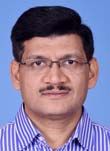 Duggirala Pallamraju
Duggirala Pallamraju
The 15th International Symposium on Equatorial Aeronomy (ISEA-15) was held at the Physical Research Laboratory (PRL), Ahmedabad, India during October 22÷26, 2018. In all 249 abstracts accepted were distributed in the seven scientific themes in ISEA-15: Equatorial E- and F-region irregularities: Cause and effects; Longitudinal dependence of equatorial electrodynamics; Mesosphere Ionosphere Thermosphere coupling at low- and mid-latitudes; Mid- and low-latitude effects of global atmospheric wave coupling; Space weather effects on low- and mid-latitudes; Results from new techniques, experiments, and campaigns; and Future trends, opportunities, and challenges in low-latitude aeronomy. There were 64 oral presentations. All the posters were displayed on all the days which provided time for extended interactions. There were around 180 participants from 22 countries, with over 60 participants from out of India. A young scientist presentation competition was held wherein 43 young scientists participated. More information about the program, abstracts and other updates are available on the ISEA-15 website (https://www.prl.res.in/isea15).
 Group Photo of Participants
Group Photo of Participantsby José Valentin Bageston
7th Symposium of
Brazilian Space Geophysics and Aeronomy Society (SBGEA)
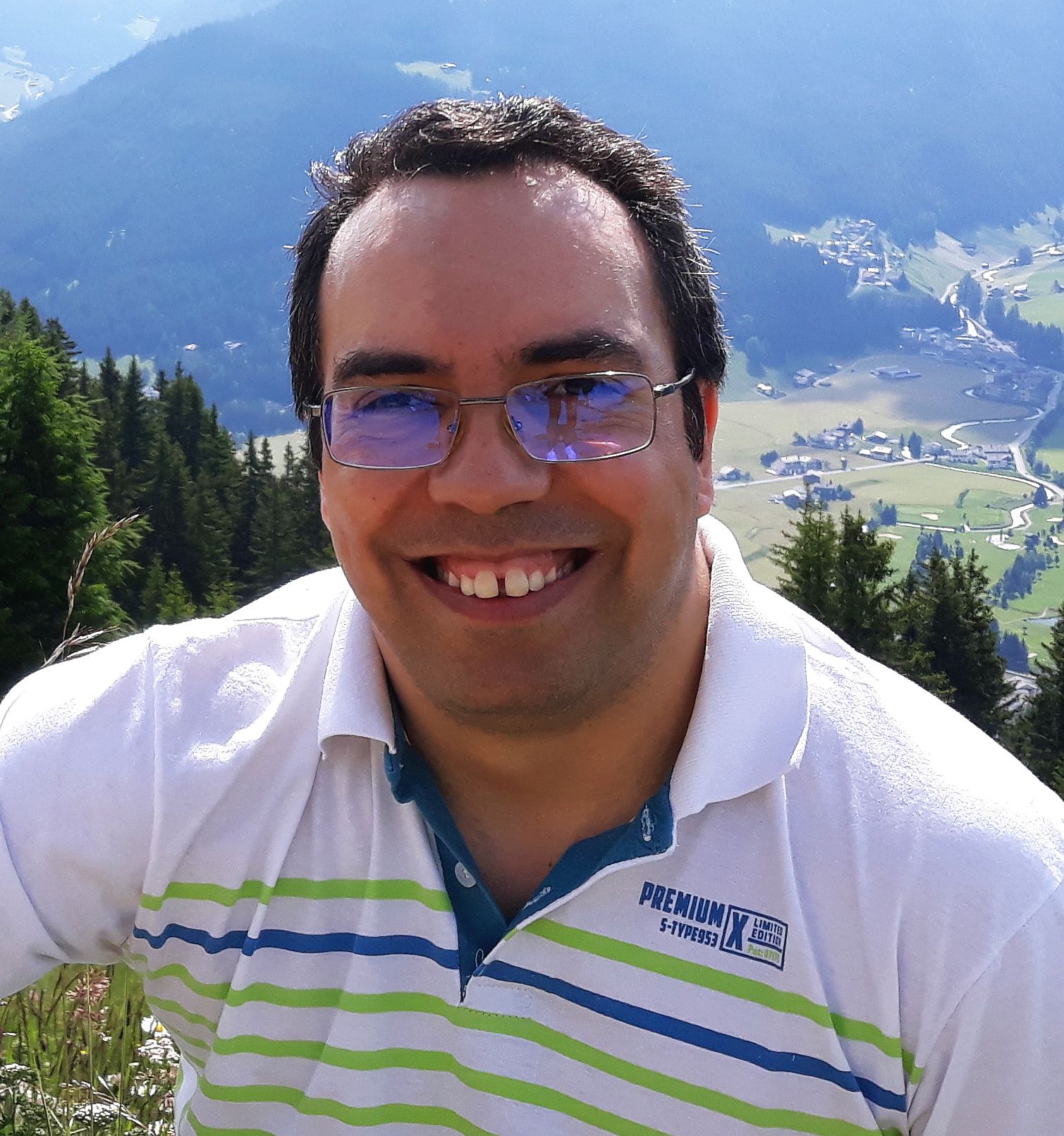 José Valentin Bageston
José Valentin Bageston
The 7th SBGEA Symposium was held at the Southern Regional Space Research Center (CRS) of the Brazilian National Institute for Space Research (INPE) from 5 to 9 November 2018, in Santa Maria-RS, Brazil. The Brazilian Space Geophysics and Aeronomy Association encourage and promote the achievement of this scientific event every two years. In this seventh edition of the SBGEA symposium, the organization was in charge of the CRS/INPE in association with the Federal University of Santa Maria (UFSM). The CRS/INPE is located in the UFSM main campus in Santa Maria, the geographical center of the Rio Grande do Sul state in the Sothern Brazil.
IntroductionThe Brazilian Symposium on Space Geophysics and Aeronomy is a traditional scientific event that takes place every two years since 2006, when INPE organized the first Symposium at São José dos Campos, SP. Then the next events were organized at different cities and regions in Brazil. The previous one was organized in 2016 by the Federal University of Goiás, at the campus of Jataí, Goiás, central region of Brazil.
The seventh edition (7th SBGEA) was held in the city of Santa Maria, localized in the central region of Rio Grande do Sul state, Southern Brazil. The main goal of this event is to bring together the Brazilian Space Geophysics and Aeronomy community for discussing recent scientific results, establish and strengthen cooperation and academic interchange, besides to plan future actions for these science areas in Brazil. Also, an important objective of the SBGEA meeting is to facilitate the approaches of students to professors and researchers, promoting a fruitful interchange of ideas and experiences.
The scientific objective of the 7th SBGEA Symposium was to show results of observational, theoretical and modeling studies obtained in recent years that will allow a better understanding of the Space phenomena, with origin in the Sun and in the interplanetary medium, which affects the whole atmosphere and Earth's climate.
Technical ReportWe have the attendance of more than 150 participants, including researcher, professors and students. The most of them were from Brazil, but several (around 10) came from abroad, specifically from United States of America, Germany, China, Mexico and Argentina. From Brazil, the most of the attendants came from Sao Paulo (65) and locally of Rio Grande do Sul (71). From northeast Brazil, 13 attendees came to Santa Maria for the 7th SBGEA, whilst other participants came from states like Goiás, Minas Gerais, Federal District (Brasília) and Paraná.
In the official opening of the 7th SBGEA we have the presence of the following authorities: table of the Rector of the Federal University of Santa Maria, Dr. Paulo Afonso Burmann; the INPE's general Director representative, Dr. Maria Virginia Alves; the president of the SBGEA, Dr. Igo Paulino, and the general coordinator (Chair) of the 7th SBGEA Symposium, Dr. José Valentin Bageston. We highlighting the presence of the band of the third Arm Division of Santa Maria that played the national and state anthems, and also the presence of general coordinators of research areas and graduation program of INPE and directors of the Technology Center and Center of Natural and Exact Sciences of UFSM, besides other under-graduation and graduation coordinators. After the opening ceremony it was stared the first technical session: Solar Physics and Planetary Magnetospheres, with the invited speaker Dr. Marcos Silveira (GSFC/NASA and Catholic University of America), given the talk titled "Magnetic reconnection and flux transfer events observed in the Earth’s dayside magnetopause". After this presentation we have a break (coffee), and after that the oral presentations of this session. In the afternoon we have the session of "Ionosphere: Earth and Planets", stating with the invited speaker Dr. Fabiano da Silveira Rodrigues (The University of Texas at Dallas). The details of the invited speakers, including the link for their abstracts, can be found at:http://www.sbgea.org.br/en/vii-sbgea-2/invited-speakers/. The 7th SBGEA was organized in 8 scientific sessions (http://www.sbgea.org.br/en/vii-sbgea-2/scientific-sessions/), with 7 invited talks (plenary of 40 minutes duration) and 43 normal oral presentations (20 minutes), totalizing 50 oral talks. Also, we have about 130 poster presentations on Thursday, November 8. Besides the technical presentations we scheduled during the official dinner (second day if the event) one regional presentation of typical dancing and history of the southern Brazilian people (gauchos), and in the following days also it was programmed three technical visits to the UFSM's planetarium, the China-Brazil Join Space Weather Laboratory at Santa Maria (Digissonde antenna) and to the Southern Space Observatory (SSO) of INPE in São Martinho da Serra-RS, about 60 km north of Santa Maria, where several instruments (multidirectional Muon detector, magnetometers, airglow cameras, imaging riometer and many other sensors), are operated by several national and international institutions. The detailed program of the 7th SBGEA can be found at http://www.sbgea.org.br/en/vii-sbgea-2/program-and-book-of-abstracts/.
Among all the attendees, 151 besides others that come eventually (not officially registered) to see specific presentations, 87 were students (58%) and 40 was female attendees (26%). Considering only the student group, 25 were female that represents about 29% of this group, a little more than the general percentage of the female attendees in the event. This is important since the young female students are interested in science, have been attending meeting like he SBGEA Symposium and other regional or national events.
After finishing the scientific sessions, with very interesting talks and poster presentations, on Friday, November 9, the event was officially closed and the Chair of the event emphasize the importance of the obtained financial support, mainly for young students and researcher in the beginning of career, which include the great support from Varsit/SCOSTEP and the SBGEA own funds, which allowed to support 18 students from different regions of Brazil and of different education levels since the under graduation till Ph.D. candidates. Also, we received important support from CAPES (Brazilian national Coordination for Improvement of Level of Professional who act in Universities and Research Institutes), FAPERGS (Rio Grande do Sul foundation for research support), and from the China-Brazil Join Space Weather Research Labs. The President of the SBGEA, Dr. Igo Paulino, heighted the importance of the event to encourage young students to follow the research career and also the need to publish the results of the research results presented in the 7th SBGEA in a special issue that will contain the main scientific contributions from this event.
The main scientific highlights from the 7th SBGEA Symposium are summarized below.
Final General Program (is available here)
Summarized statistics of the attendees at the 7th SBGEA:
The attendees came from seventeen (17) different Brazilian institutions (Universities and Research Institutes) and from seven (7) foreign institutions of five (5) distinct countries (United States of America, Germany, China, Mexico and Argentina).
| Total of attendees: 151 | |
| Total of male attendees: 111 | Total of female attendees: 40 (~26% of the total) |
| Brazilian attendees: 141 (~93% of the total) | Foreign attendees: 10 |
| Total of students attendees: 87 (~58% of the total) | |
Acknowledgements: The 7th SBGEA Local Organizing Committee would like the thank for the financial support from VarSITI/SCOSTEP. Also, we thank to the SBGEA. We are grateful to CAPES, FAPERGS and CBJLSW/NSSC/CAS for the support given to the invited speaks and researcher/professors from northeast Brazil.
